Mars
Roman god
 ancient Roman deity, in importance second only to Jupiter. Little is known of his original character, and that character (chiefly from the cult at Rome) is variously interpreted. It is clear that by historical times he had developed into a god of war; in Roman literature he was protector of Rome, a nation proud in war.
ancient Roman deity, in importance second only to Jupiter. Little is known of his original character, and that character (chiefly from the cult at Rome) is variously interpreted. It is clear that by historical times he had developed into a god of war; in Roman literature he was protector of Rome, a nation proud in war.Mars's festivals at Rome occurred in the spring and the fall—the beginning and the end of both the agricultural and the military seasons. The month of March, which was named after him, was especially filled with festivals wholly or partially in his honour; the members of the ancient priesthood of the Salii, who were particularly associated with Jupiter, Mars, and Quirinus, came out several times during the month to dance their ceremonial war dance in old-fashioned armour and chant a hymn to the gods. October was also an important month for Mars. At the festival of the October Horse on October 15, a two-horse chariot race was held in the Campus Martius, and on October 19 the Armilustrium marked the purification of the arms of war and their storage for the winter. The god was invoked in the ancient hymn of the Arval Brothers, whose religious duties had as their object to keep off enemies of all kinds from crops and herds.
Until the time of Augustus, Mars had only two temples at Rome: one was in the Campus Martius, the exercising ground of the army; the other was outside the Porta Capena. Within the city there was a sacrarium (“shrine,” or “sanctuary”) of Mars in the regia, originally the king's house, in which the sacred spears of Mars were kept; upon the outbreak of war the consul had to shake the spears saying, “Mars vigila” (“Mars, wake up!”).
Under Augustus the worship of Mars at Rome gained a new impetus; not only was he traditional guardian of the military affairs of the Roman state but, as Mars Ultor (“Mars the Avenger”), he became the personal guardian of the emperor in his role as avenger of Caesar. His worship at times rivaled that of Capitoline Jupiter, and about AD 250 Mars became the most prominent of the di militares (“military gods”) worshiped by the Roman legions. In literature and art he is hardly distinguished from the Greek Ares.
There are several Roman myths about Mars. In one, Hera bore him, without Zeus, at the touch of a magic herb given her by Flora. In another, he was the father of Romulus and Remus by Rhea Silvia, a Vestal Virgin. Ovid, in Fasti, tells of Mars's attempt to seduce Minerva. In the only purely Roman myth, he is tricked into marrying the aged Anna Perenna.
planet
Introduction
 fourth planet in the solar system in order of distance from the Sun and seventh in size and mass. It is a conspicuous, sometimes quite bright, reddish object in the night sky. Mars is designated by the symbol ♂.
fourth planet in the solar system in order of distance from the Sun and seventh in size and mass. It is a conspicuous, sometimes quite bright, reddish object in the night sky. Mars is designated by the symbol ♂. Planetary data for Mars Planetary data for MarsBlood-red in colour and sometimes called the Red Planet, Mars has long been associated with warfare and slaughter. It is named for the Roman god of war. As long as 3,000 years ago, Babylonian astronomer-astrologers called the planet Nergal for their god of death and pestilence. The planet's two moons, Phobos (Greek: “Fear”) and Deimos (“Terror”), were named for two of the sons of Ares and Aphrodite (the counterparts of Mars and Venus, respectively, in Greek mythology).
In recent times, Mars has intrigued people for more substantial reasons than its baleful appearance. The planet is the second closest to Earth, after Venus, and it is usually easy to observe in the night sky because its orbit lies outside Earth's. It is also the only planet whose solid surface and atmospheric phenomena can be seen in telescopes from Earth. Centuries of assiduous studies by earthbound observers, which have been extended by spacecraft observations since the 1960s, have revealed that Mars is similar to Earth in many ways. Like Earth, Mars has clouds, winds, a roughly 24-hour day, seasonal weather patterns, polar ice caps, volcanoes, canyons, and other familiar features. There are intriguing clues that billions of years ago Mars was even more Earth-like than today, with a denser, warmer atmosphere and much more water—rivers, lakes, flood channels, and perhaps oceans. By all indications, Mars is now a sterile frozen desert, but close-up images from the Mars Global Surveyor spacecraft of seemingly water-eroded gullies suggest that at least small amounts of water may have flowed on or near the planet's surface in geologically recent times and may still exist as a liquid in protected areas below the surface. The presence of water on Mars is considered a critical issue because, without water, life as it is presently understood cannot exist. If microscopic life-forms ever did originate on Mars, there remains a chance, albeit a remote one, that they may yet survive in these hidden watery niches. In 1996 a team of scientists reported what they concluded to be evidence for ancient microbial life in a piece of meteorite that had come from Mars, but most scientists have disputed their interpretation.
Since at least the end of the 19th century, Mars has been considered the most obviously hospitable place in the solar system beyond Earth both for indigenous life to have developed and for human exploration and habitation. At that time, speculation was rife that the so-called canals of Mars (Mars, canals of)—complex systems of long, straight surface lines that very few astronomers had claimed to see in telescopic observations—were indeed the creations of intelligent beings. Seasonal changes in the planet's appearance that were seemingly related to the spread and retreat of vegetation added to the purported evidence for biological activity. Although the canals later proved to be illusory and the seasonal changes geologic rather than biological, scientific and public interest in the possibility of Martian life and in exploration of the planet has not faded.
During the past century Mars has taken on a special place in popular culture. It has served as inspiration for generations of fiction writers from H.G. Wells (Wells, H.G.) and Edgar Rice Burroughs (Burroughs, Edgar Rice) in the heyday of the Martian canals to Ray Bradbury (Bradbury, Ray) in the 1950s and Kim Stanley Robinson in the '90s. Mars has also been a central theme in radio, television, and film, perhaps the most notorious case being Orson Welles (Welles, Orson)'s radio-play production of H.G. Wells's novel War of the Worlds, which convinced thousands of unwitting listeners on the evening of October 30, 1938, that beings from Mars were invading Earth. The planet's mystique and many real mysteries remain a stimulus to both scientific inquiry and human imagination to this day.
Basic astronomical data
Mars moves around the Sun at a mean distance (synodic period) of 228 million km (140 million miles), or about 1.5 times that of Earth from the Sun. Because of its relatively elongated orbit, the distance between Mars and the Sun varies from 206.6 million to 249.2 million km (128.4 million to 154.8 million miles). Mars orbits the Sun once in 687 Earth days, which means that its year is nearly twice as long as Earth's. At its closest approach, Mars is less than 56 million km (35 million miles) from Earth, but it recedes to almost 400 million km (250 million miles) when the two planets are on opposite sides of the solar system.
Mars is easiest to observe when it and the Sun are in opposite directions in the sky—i.e., at opposition—because it is then high in the sky and shows a fully lighted face. Successive oppositions occur about every 26 months. Oppositions can take place at different points in the Martian orbit. Those best for viewing occur when the planet is closest to the Sun, and so also to Earth, because Mars is then at its brightest and largest. Close oppositions occur roughly every 15 years.
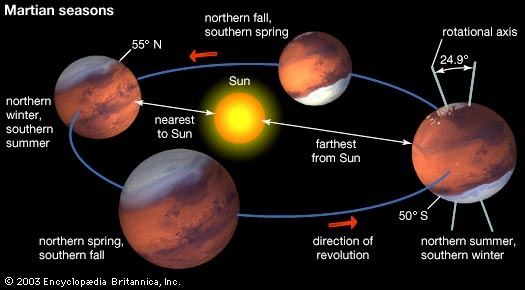 Mars spins on its axis once every 24 hours 37 minutes, making a day on Mars only a little longer than an Earth day. Its axis of rotation is inclined to its orbital plane by about 25°, and, as for Earth, the tilt gives rise to seasons (season) on Mars. (See the diagram-->
Mars spins on its axis once every 24 hours 37 minutes, making a day on Mars only a little longer than an Earth day. Its axis of rotation is inclined to its orbital plane by about 25°, and, as for Earth, the tilt gives rise to seasons (season) on Mars. (See the diagram--> .) The Martian year consists of 668.6 Martian solar days, called sols. As a result, southern summers (summer) are shorter (154 Martian days) and warmer than those in the north (178 Martian days). The situation, however, is slowly changing such that 25,000 years from now the northern summers will be the shorter and warmer ones. In addition, the tilt of the axis is slowly changing on a roughly one-million-year timescale. During some epochs the tilt is close to zero, and so Mars has no seasons; in other epochs the tilt may be as high as 35°, resulting in extreme seasonal differences.
.) The Martian year consists of 668.6 Martian solar days, called sols. As a result, southern summers (summer) are shorter (154 Martian days) and warmer than those in the north (178 Martian days). The situation, however, is slowly changing such that 25,000 years from now the northern summers will be the shorter and warmer ones. In addition, the tilt of the axis is slowly changing on a roughly one-million-year timescale. During some epochs the tilt is close to zero, and so Mars has no seasons; in other epochs the tilt may be as high as 35°, resulting in extreme seasonal differences. Planetary data for MarsMars is a small planet, larger than only Mercury and slightly more than half the size of Earth. It has an equatorial radius of 3,396 km (2,110 miles) and a mean polar radius of 3,379 km (2,100 miles), both values accurately determined by the Mars Global Surveyor spacecraft, which began its primary mission in orbit around the planet in 1999. The mass of Mars is only one-tenth the terrestrial value, and its gravitational acceleration of 3.72 metres (12.2 feet) per second per second at the surface means that objects on Mars weigh a little more than a third of their weight on Earth's surface. Mars has only 28 percent of the surface area of Earth, but, because about three-fourths of Earth is covered by water, the land areas of the two planets are comparable. For additional orbital and physical data, see the table (Planetary data for Mars).
Early telescopic (telescope) observations
Mars was an enigma to ancient astronomers, who were bewildered by its apparently capricious motion across the sky—sometimes in the same direction as the Sun and other celestial objects (direct, or prograde, motion), sometimes in the opposite direction ( retrograde motion). In 1609 the German astronomer Johannes Kepler (Kepler, Johannes) used the superior naked-eye observations of the planet by his Danish colleague Tycho Brahe (Brahe, Tycho) to deduce empirically its laws of motion (Kepler's laws of planetary motion) and so pave the way for the modern gravitational theory of the solar system. Kepler found that the orbit of Mars was an ellipse along which the planet moved with nonuniform but predictable motion. Earlier astronomers had based their theories on the older Ptolemaic (Ptolemaic system) idea of hierarchies of circular orbits and uniform motion.
The earliest telescopic observations of Mars in which the disk of the planet was seen were those of the Italian astronomer Galileo in 1610. The Dutch scientist and mathematician Christiaan Huygens (Huygens, Christiaan) is credited with the first accurate drawings of surface markings. In 1659 Huygens made a drawing of Mars showing a major dark marking on the planet now known as Syrtis Major. The Martian polar caps were first noted by the Italian-born French astronomer Gian Domenico Cassini (Cassini, Gian Domenico) about 1666.
Visual observers made many key discoveries. The rotation of the planet was discovered by Huygens in 1659 and measured by Cassini in 1666 to be 24 hours 40 minutes—in error by only 3 minutes. The tenuous Martian atmosphere was first noted in the 1780s by the German-born British astronomer William Herschel (Herschel, Sir William), who also measured the tilt of the planet's rotation axis and first discussed the seasons of Mars. In 1877 Asaph Hall (Hall, Asaph) of the U.S. Naval Observatory discovered that Mars has two natural satellites. Visual observations also documented many meteorological and seasonal phenomena that occur on Mars, such as various cloud types, the growing and shrinking of the polar caps, seasonal changes in the colour and extent of the dark areas, an annual “wave of darkening” in the markings that sweeps across the planet in phase with the shrinking of the polar caps, and an occasional “blue haze” in the atmosphere. The explanation of most of these, however, had to await the scientific exploration of Mars by spacecraft.
General appearance
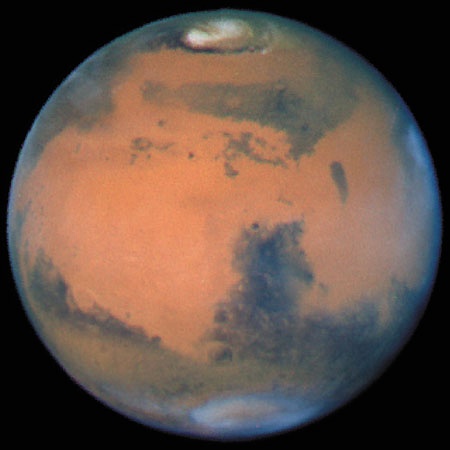 To the Earth-based telescopic observer, the Martian surface outside the polar caps is characterized by red-ochre-coloured bright areas on which dark markings appear superimposed. In the past, the bright areas were referred to as deserts, and the majority of large dark areas were originally called maria (Latin: “oceans” or “seas”; singular mare) in the belief that they were covered by expanses of water.
To the Earth-based telescopic observer, the Martian surface outside the polar caps is characterized by red-ochre-coloured bright areas on which dark markings appear superimposed. In the past, the bright areas were referred to as deserts, and the majority of large dark areas were originally called maria (Latin: “oceans” or “seas”; singular mare) in the belief that they were covered by expanses of water.Surface features
The dark markings cover about one-third of the Martian surface, mostly in a band around the planet between latitudes 10° and 40° S. Their distribution is irregular, and their gross pattern has been observed to change over timescales of tens to hundreds of years. The northern hemisphere has only three such major features—Acidalia Planitia, Syrtis Major, and a dark collar around the pole—which were once considered to be shallow seas or vegetated regions. It is now known that Mars's dark areas form and change as winds move materials around the surface. Viewed in close-up images taken by spacecraft, they are seen to be formed by many separate and grouped dark streaks and splotches that are associated with craters, ridges, hills, and other obstructions to the flow of local winds. Seasonal and longer-term variations in size and colour of the dark areas probably reflect changes in the proportion of surface covered by various bright and dark materials.
The bright areas, which represent about two-thirds of the planet's surface, display subtle shadings, but these probably also are the result of differences in the distribution of windblown materials on the surface. The canals (Mars, canals of) that figured so prominently on maps made from telescopic observations around the turn of the 20th century (see the section The mapping of Mars (Mars), below) are not visible in close-up spacecraft images from flyby and orbital missions, beginning with Mariner 4 in 1965. They were almost certainly imaginary features that observers thought they saw while straining to make out objects close to the limit of resolution of their telescopes. Other features, such as the “wave of darkening” and the “blue haze” described by early observers at the telescope, are now known to result from a combination of the viewing conditions and changes in the reflective properties of the surface.
Polar regions
For telescopic observers, the most striking regular changes on Mars occur at the poles. With the onset of fall in a particular hemisphere, clouds develop over the relevant polar region, and the cap, made of frozen carbon dioxide, begins to grow. The smaller cap in the north ultimately extends to 55° latitude, the larger one in the south to 50° latitude. In spring the caps recede. During summer the northern carbon dioxide cap disappears completely, leaving behind a small water-ice cap. In the south a small residual cap composed of carbon dioxide ice and water ice lingers over the summer.
Transient atmospheric phenomena
Early telescopic observers noted instances in which Martian surface features were temporarily obscured. They generally classified the cause as being white clouds (cloud) or yellow clouds, which were correctly interpreted as due to condensed gas or dust, respectively. Spacecraft observations have confirmed that hazes, clouds, and fogs commonly veil the surface.
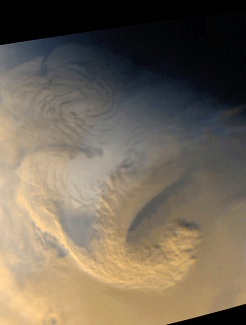 Images from spacecraft in Mars's orbit have documented a variety of low-lying clouds and fogs that are often confined within topographic depressions—i.e., valleys or craters. They have also revealed high, thin clouds, particularly at the morning terminator (the dividing line between the lit and unlit portions of the planet's disk). Orographic clouds, produced when moist air is lifted over elevated terrain and cooled, form around prominent topographic features such as craters and volcanoes, and winter at midlatitudes is characterized by westward-moving, spiral-shaped storm systems, similar to those on Earth. Most of these clouds are composed of water ice—the white clouds seen by the early observers.
Images from spacecraft in Mars's orbit have documented a variety of low-lying clouds and fogs that are often confined within topographic depressions—i.e., valleys or craters. They have also revealed high, thin clouds, particularly at the morning terminator (the dividing line between the lit and unlit portions of the planet's disk). Orographic clouds, produced when moist air is lifted over elevated terrain and cooled, form around prominent topographic features such as craters and volcanoes, and winter at midlatitudes is characterized by westward-moving, spiral-shaped storm systems, similar to those on Earth. Most of these clouds are composed of water ice—the white clouds seen by the early observers.Dust storms are common on Mars. They can occur at any time but are most frequent in southern spring and summer, when Mars is passing closest to the Sun and surface temperatures are at their highest. Most of the storms are regional in extent and last a few weeks. Every second or third year, however, the dust storms become global. At their peak, dust is carried so high in the atmosphere that only the summits of the loftiest volcanoes—up to 21 km (13 miles) above the planet's mean radius—are visible.
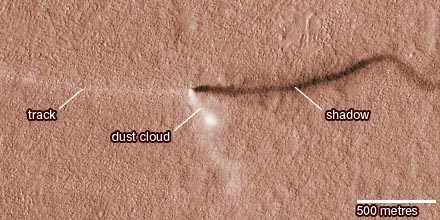 Although too small to be observed from Earth, dust devils (dust devil) (see whirlwind) have been seen from Mars orbit and at the landing site of the Mars Pathfinder spacecraft. Narrow tracks, thought to be caused by dust devils, are also visible in high-resolution images taken from orbit by Mars Global Surveyor.
Although too small to be observed from Earth, dust devils (dust devil) (see whirlwind) have been seen from Mars orbit and at the landing site of the Mars Pathfinder spacecraft. Narrow tracks, thought to be caused by dust devils, are also visible in high-resolution images taken from orbit by Mars Global Surveyor.The atmosphere
Basic atmospheric data
The American astronomer Gerard P. Kuiper (Kuiper, Gerard Peter) ascertained from telescopic observations in 1947 that the Martian atmosphere is composed mainly of carbon dioxide. The atmosphere is very thin, exerting less than 1 percent of Earth's atmospheric pressure at the surface. Surface pressures range over a factor of 15 because of the large altitude variations in Mars's topography. Only small amounts of water are present in the atmosphere today. If it all precipitated out, it would form a layer of ice crystals only 10 micrometres (0.0004 inch) thick, which could be gathered into a solid block of ice not much larger than a medium-size terrestrial iceberg. As discussed in later sections, geologic evidence suggests that the atmosphere was much denser in the remote past and that water was once much more abundant at the surface.
The characteristic temperature in the lower atmosphere is about 200 kelvins (K; −100 °F, −70 °C), which is generally colder than the average daytime surface temperature of 250 K (−10 °F, −20 °C). These values are in the same range as those experienced on Earth in Antarctica during winter. In summer above a very dark surface, daytime temperatures at the height of a human being can peak at about 290 K (62 °F, 17 °C). Above the turbulent layer close to the surface, temperature decreases with elevation at a rate of about 1.5 K (2.7 °F, 1.5 °C) per km (about 2.4 K 【4.3 °F, 2.4 °C】 per mile) of altitude.
Unlike that of Earth, the atmosphere of Mars experiences large seasonal variations in pressure as carbon dioxide, the main constituent, “snows out” at the winter pole and returns directly to a gas (sublimes) in the spring. Because the southern winter cap is more extensive than the northern, atmospheric pressure reaches a minimum during southern winter when the southern cap is at its largest. From Viking lander measurements of the pressure, which was found to vary by 26 percent annually over the mean, scientists calculated that some 7.9 trillion metric tons of carbon dioxide leave and reenter the atmosphere seasonally. This is equivalent to a thickness of at least 23 cm (9 inches) of solid carbon dioxide (dry ice) or several metres of carbon dioxide snow averaged over the vast area of the seasonal polar caps.
Composition and surface pressure
mars, composition of atmosphereDirect chemical analysis at the surface by the Viking landers and spectral observations from orbiting spacecraft have allowed scientists to determine the composition of the Martian atmosphere to high precision. Where the atmosphere is well mixed by turbulence—below an altitude of 125 km (about 80 miles)—95.3 percent of the atmosphere by weight is carbon dioxide (see the table (mars, composition of atmosphere)). This is a comparatively large amount—nine times the quantity now in Earth's much more massive atmosphere. Much of Earth's carbon dioxide, however, is chemically locked in sedimentary rocks; the amount in the Martian atmosphere is less than a thousandth of the terrestrial total. The balance of the Martian atmosphere consists of molecular nitrogen, water vapour, and noble gases (argon, neon, krypton, and xenon). There are also trace amounts of gases that have been produced from the primary constituents by photochemical reactions (photochemical reaction), generally high in the atmosphere; these include molecular oxygen, carbon monoxide, nitric oxide, and small amounts of ozone.
The lower atmosphere supplies gas to the planet's ionosphere (ionosphere and magnetosphere), where densities are low, temperatures are high, and components separate by diffusion according to their masses. Various constituents in the top of the atmosphere are lost to space, which affects the isotopic composition of the remaining gases. For example, because hydrogen is lost preferentially over its heavier isotope deuterium, Mars's atmosphere contains five times more deuterium than Earth's.
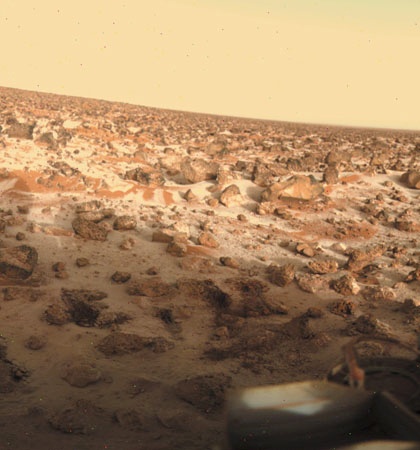 Although water is only a minor constituent of the Martian atmosphere (a few molecules per 10,000 at most), primarily because of low atmospheric and surface temperatures, it plays an important role in atmospheric chemistry and meteorology. The Martian atmosphere is effectively saturated with water vapour, yet there is no liquid water present on the surface. The temperature and pressure of the planet are so low that water molecules can exist only as ice or as vapour. Little water is exchanged daily with the surface despite the very cold nighttime surface temperatures.
Although water is only a minor constituent of the Martian atmosphere (a few molecules per 10,000 at most), primarily because of low atmospheric and surface temperatures, it plays an important role in atmospheric chemistry and meteorology. The Martian atmosphere is effectively saturated with water vapour, yet there is no liquid water present on the surface. The temperature and pressure of the planet are so low that water molecules can exist only as ice or as vapour. Little water is exchanged daily with the surface despite the very cold nighttime surface temperatures.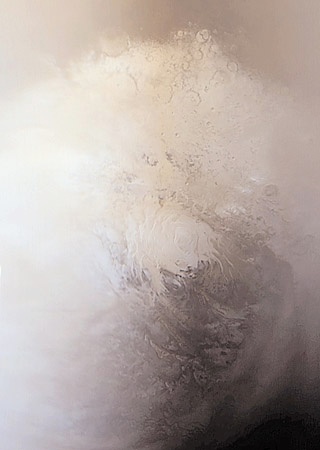 Most of the information about atmospheric water on Mars has come from the Viking orbiters, which observed seasonal patterns of water content in the atmosphere over a full Martian year. Water vapour is mixed uniformly up to altitudes of 10–15 km (6–9 miles) and shows strong latitudinal gradients that depend on the season. The largest changes occur in the northern hemisphere. During summer in the north, the complete disappearance of the carbon dioxide cap leaves behind a water-ice cap. Sublimation of water from the residual cap results in a strong north-to-south concentration gradient of water vapour in the atmosphere. In the south, where a small carbon dioxide cap remains in summer and only a small amount of water ice has been detected, a strong water vapour gradient does not normally develop in the atmosphere.
Most of the information about atmospheric water on Mars has come from the Viking orbiters, which observed seasonal patterns of water content in the atmosphere over a full Martian year. Water vapour is mixed uniformly up to altitudes of 10–15 km (6–9 miles) and shows strong latitudinal gradients that depend on the season. The largest changes occur in the northern hemisphere. During summer in the north, the complete disappearance of the carbon dioxide cap leaves behind a water-ice cap. Sublimation of water from the residual cap results in a strong north-to-south concentration gradient of water vapour in the atmosphere. In the south, where a small carbon dioxide cap remains in summer and only a small amount of water ice has been detected, a strong water vapour gradient does not normally develop in the atmosphere.The atmospheric water vapour is believed to be in contact with a much larger reservoir in the Martian soil. Subsurface layers of ice are thought to be ubiquitous on Mars at latitudes poleward of 40°; the very low subsurface temperatures would prevent the ice from subliming. The 2001 Mars Odyssey spacecraft, which began orbital observations of the planet in late 2001, confirmed that ice is present within a metre of the surface at these latitudes, but it is not known how deep the ice layer extends. In contrast, at low latitudes, ice is unstable, and any ice present in the ground would tend to sublime into the atmosphere.
The Viking landers' analytical instruments also measured the isotopic composition of the major and minor atmospheric gases. The similarity of the ratios of isotopes of carbon and oxygen to their terrestrial values implies that large reservoirs of carbon dioxide and water ice exist on Mars and that gases from the reservoirs exchange with those in the atmosphere. The results of other isotopic measurements from Viking suggest that larger amounts of carbon dioxide, nitrogen, and argon were present in the atmosphere in the past and that Mars may have lost much of its inventory of volatile substances early in its history, either to space or to the ground (i.e., locked up chemically in rocks). Some scientists have conjectured that Mars may once have had a much thicker atmosphere but that it was lost to the surface through chemical reactions, which formed carbonates, and to space through large asteroid impacts, which blew off atmospheric gases.
Atmospheric structure
The vertical structure of the Martian atmosphere—that is, the relation of temperature and pressure to altitude—is determined partly by a complicated balance of several energy-transport mechanisms and partly by the way energy from the Sun is introduced into the atmosphere and lost by radiation to space.
Two factors control the vertical structure of the lower atmosphere—its composition of almost pure carbon dioxide and its content of large quantities of suspended dust. Because carbon dioxide radiates energy efficiently at Martian temperatures, the atmosphere can respond rapidly to changes in the amount of solar radiation received. The suspended dust (interplanetary dust particle) absorbs large quantities of heat directly from sunlight and provides a distributed source of energy throughout the lower atmosphere.
Surface temperatures (temperature) depend on latitude and fluctuate over a wide range from day to night. At the Viking 1 and Pathfinder (Mars Pathfinder) landing sites (both about 20° N latitude), the temperatures at roughly human height above the surface regularly varied from a low near 189 K (−119 °F, −84 °C) just before sunrise to a high of 240 K (−28 °F, −33 °C) in the early afternoon. This temperature swing is much larger than occurs in desert regions on Earth. The variation is greatest very close to the ground and occurs because the thin, dry atmosphere allows the surface to radiate its heat quickly during the night. During dust storms this ability is impaired, and the temperature swing is reduced. Above altitudes of a few kilometres, the daily variation is damped out, but other oscillations appear throughout the atmosphere as a result of the direct input of solar energy. These temperature and pressure oscillations, sometimes called tides because they are regular, periodic, and synchronized with the position of the Sun, give the Martian atmosphere a very complex vertical structure.
The cooling of the atmosphere with altitude at a rate of 1.5 K per km continues upward to about 40 km (25 miles), at which level (called the tropopause) the temperature becomes a roughly constant 140 K (−210 °F, −130 °C). This rate, measured by the Viking (and later Pathfinder) spacecraft as they descended through the atmosphere, was unexpectedly low; scientists had anticipated it to be near 5 K per km. Moreover, the tropopause was expected to occur at a much lower altitude, about 15 km (9 miles). The large amount of suspended dust is thought to be responsible for these differences.
Above 100 km (60 miles), the structure of the atmosphere is determined by the tendency of the heavier molecules to concentrate below the lighter ones. This diffusive separation process overcomes the tendency of turbulence to mix all the constituents together. At these high altitudes, absorption of ultraviolet light from the Sun dissociates and ionizes the gases and leads to complex sequences of chemical reactions. The top of the atmosphere has an average temperature of about 300 K (80 °F, 27 °C).
Meteorology and atmospheric dynamics
The global pattern of atmospheric circulation on Mars shows many superficial similarities to that of Earth, but the root causes are very different. Among these differences are the atmosphere's ability to adjust rapidly to local conditions of solar heat input; the lack of oceans, which on Earth have a large resistance to temperature changes; the great range in altitude of the surface (see the section Character of the surface (Mars), below); the strong internal heating of the atmosphere because of suspended dust; and the seasonal deposition and release of a large part of the Martian atmosphere at the poles.
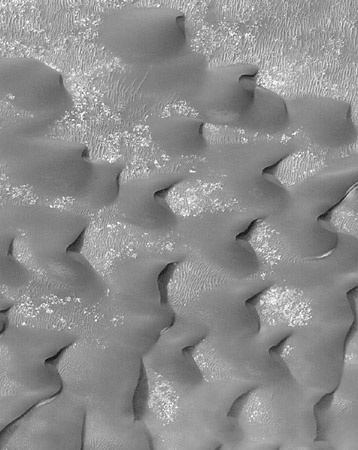 The only direct measurements of wind speeds were made by the Viking and Pathfinder landers. Near-surface winds at these sites were usually regular in behaviour and generally light. Average speeds were typically less than 2 metres per second (4.5 miles per hour), although gusts up to 40 metres per second (90 miles per hour) were recorded. Other observations, including streaks of windblown dust and patterns in dune fields and in the many varieties of clouds, have provided additional clues about surface winds.
The only direct measurements of wind speeds were made by the Viking and Pathfinder landers. Near-surface winds at these sites were usually regular in behaviour and generally light. Average speeds were typically less than 2 metres per second (4.5 miles per hour), although gusts up to 40 metres per second (90 miles per hour) were recorded. Other observations, including streaks of windblown dust and patterns in dune fields and in the many varieties of clouds, have provided additional clues about surface winds.Global circulation models, which incorporate all the factors understood to influence the behaviour of the atmosphere, predict a strong dependence of winds on the Martian seasons because of the large horizontal temperature gradients associated with the edge of the polar caps in the fall and winter. Strong jet streams with eastward velocities above 100 metres per second (225 miles per hour) form at high latitudes in winter. Circulation is less dramatic in spring and fall, when light winds predominate everywhere. On Mars, unlike on Earth, there is also a relatively strong north-south circulation that transports the atmosphere to and from the winter and summer poles. The general circulation pattern is occasionally unstable and exhibits large-scale wave motions and instabilities: a regular series of rotating high- and low-pressure systems was clearly seen in the pressure and wind records at the Viking lander sites.
Smaller-scale motions and oscillations, driven both by the Sun and by surface topography, are ubiquitous. For example, at the Viking and Pathfinder landing sites, the winds change in direction and speed throughout the day in response to the position of the Sun and the local slope of the land.
Turbulence is an important factor in raising and maintaining the large quantity of dust found in the Martian atmosphere. Dust storms tend to begin at preferred locations in the southern hemisphere during the southern spring and summer. Activity is at first local and vigorous (for reasons yet to be understood), and large amounts of dust are thrown high into the atmosphere. If the amount of dust reaches a critical quantity, the storm rapidly intensifies, and dust is carried by high winds to all parts of the planet. In a few days the storm obscures the entire surface, and visibility is reduced to less than 5 percent of normal. The intensification process is evidently short-lived, as atmospheric clarity begins to return almost immediately, becoming normal typically in a few weeks.
The polar caps
Seasonal (season) changes
 The seasonal behaviour of the Martian polar caps is well-documented. Early each southern spring, the southern carbon dioxide cap starts to recede from its maximum extent of 50° S. As spring progresses, the cap shrinks by as much as 1° of latitude every five days. The edge of the cap becomes ragged, controlled by local topography (e.g., craters), and eventually it breaks into well-defined fragments. From year to year, the location of the fragments remains about the same, although there are small variations in detail. Over the course of one-third of the Martian year, the cap recedes to its smallest extent; it is then not usually visible from Earth, but spacecraft observations have confirmed the presence of a small remnant throughout the summer.
The seasonal behaviour of the Martian polar caps is well-documented. Early each southern spring, the southern carbon dioxide cap starts to recede from its maximum extent of 50° S. As spring progresses, the cap shrinks by as much as 1° of latitude every five days. The edge of the cap becomes ragged, controlled by local topography (e.g., craters), and eventually it breaks into well-defined fragments. From year to year, the location of the fragments remains about the same, although there are small variations in detail. Over the course of one-third of the Martian year, the cap recedes to its smallest extent; it is then not usually visible from Earth, but spacecraft observations have confirmed the presence of a small remnant throughout the summer.Regrowth of the southern cap begins, after a brief period of atmospheric clarity, with the rapid formation of obscuring clouds called the polar hood. On occasion the hood is sufficiently transparent to red light to let spacecraft view the formation of the cap. These limited opportunities, however, have not allowed its rate of advance toward the equator to be accurately known. The hood is far more extensive than the cap itself and can reach to within 35° of the equator. It probably contains particles of frozen water and carbon dioxide.
Differences in the behaviour of the northern carbon dioxide cap—including its smaller maximum size in winter and complete disappearance in summer—are due to differences in the lengths of seasons for the two hemispheres, in the distances from the Sun during their respective winters, and in elevation between the two poles. Recession of the seasonal cap in the north is much more regular than in the south because of the presence of level plains over much of the high northern latitudes. Advance of the northern polar cap has been less well observed than in the south because of thicker, more extensive polar clouds.
Composition of the caps
The composition of the seasonal polar caps was the subject of debate for nearly 200 years. One early hypothesis—that the caps were made of water ice—can be traced to Herschel (Herschel, Sir William), who imagined them to be just like those on Earth. In 1898 an Irish scientist, George J. Stoney (Stoney, George Johnstone), questioned this theory and suggested that the caps might consist of frozen carbon dioxide, but evidence to support the idea was not available until Kuiper (Kuiper, Gerard Peter)'s 1947 detection of carbon dioxide in the atmosphere.
In 1966 the American scientists Robert Leighton and Bruce Murray published the results of a numerical model of the thermal environment on Mars that raised considerable doubt about the water ice hypothesis. Their calculations indicated that, under Martian conditions, atmospheric carbon dioxide would freeze at the poles, and the growth and shrinkage of their model carbon dioxide caps mimicked the observed behaviour of the actual caps. The model predicted that the seasonal caps were relatively thin, only a few metres deep near the poles and thinning toward the equator. Although based on simplifications of the actual conditions on Mars, their results were later confirmed by thermal and spectral measurements taken by the twin Mariner 6 and 7 spacecraft when they flew by Mars in 1969.
 The composition of the summer remnant caps, particularly the southern one, remains somewhat less certain despite considerable data on their thermal and radiative properties. Measurements by the Viking orbiters showed that the ice of the northern remnant is unquestionably frozen water. Added to this evidence is the large increase in the amount of water vapour detected in the atmosphere over the summer cap. The northern remnant cap, in fact, represents the largest known reservoir of available water on the planet. At the south pole, the carbon dioxide cap does not completely disappear in summer. A small remnant, consisting mostly of carbon dioxide but containing as much as 10 percent water, remains. Measurements by the Mars Express orbiter in 2004 revealed that water ice also is present just below the surface over wide areas around the remnant cap. Almost no water vapour is normally observed in the atmosphere above the southern remnant cap.
The composition of the summer remnant caps, particularly the southern one, remains somewhat less certain despite considerable data on their thermal and radiative properties. Measurements by the Viking orbiters showed that the ice of the northern remnant is unquestionably frozen water. Added to this evidence is the large increase in the amount of water vapour detected in the atmosphere over the summer cap. The northern remnant cap, in fact, represents the largest known reservoir of available water on the planet. At the south pole, the carbon dioxide cap does not completely disappear in summer. A small remnant, consisting mostly of carbon dioxide but containing as much as 10 percent water, remains. Measurements by the Mars Express orbiter in 2004 revealed that water ice also is present just below the surface over wide areas around the remnant cap. Almost no water vapour is normally observed in the atmosphere above the southern remnant cap.Polar terrain
The terrain in the polar regions is among the most distinctive on Mars. Beneath the seasonal and remnant caps at both poles, stacks of layered deposits up to 3 km (2 miles) thick extend out to about the 80° latitude circle. The layers are exposed in escarpments and valleys that have a distinctive spiral pattern. Water ice has been detected in the upper 1 metre (about 3.3 feet) of the layered terrains at both poles, and the entire stack of layered deposits at each location is likely to be mostly water ice with variable amounts of dust. The layering is thought to result from climate-caused variations in the deposition rates of dust and water ice, which are traceable to changes in the planet's orbit and rotation. The layered terrains in the north lack impact craters, suggesting that they are very young. In contrast, cratering of the layered terrains in the south indicate an age of roughly 100 million years.
The north polar region also contains the largest area of sand dunes on Mars. The dunes, which occupy the northern part of the plain known as Vastitas Borealis, form a band that almost completely encircles the north polar remnant cap. Interlayering of sand and seasonal carbon dioxide snow can be seen in some locations, indicating that the dunes are active on at least a seasonal timescale.
Character of the surface
 The character of the Martian terrain has been well established from spacecraft photography and altimetry. The entire planet was photographed by the Viking orbiters at a resolution of roughly 250 metres (820 feet) and selected areas at resolutions down to 10 metres (33 feet). Subsequently the camera on the Mars Global Surveyor spacecraft photographed selected areas with resolutions of 1.4 metres (4.6 feet), but it covered only a small fraction of the planet. The topography of the Martian surface was determined very accurately with the laser altimeter aboard Mars Global Surveyor, which mapped elevations with a vertical resolution of a few metres. (See the map-->
The character of the Martian terrain has been well established from spacecraft photography and altimetry. The entire planet was photographed by the Viking orbiters at a resolution of roughly 250 metres (820 feet) and selected areas at resolutions down to 10 metres (33 feet). Subsequently the camera on the Mars Global Surveyor spacecraft photographed selected areas with resolutions of 1.4 metres (4.6 feet), but it covered only a small fraction of the planet. The topography of the Martian surface was determined very accurately with the laser altimeter aboard Mars Global Surveyor, which mapped elevations with a vertical resolution of a few metres. (See the map--> .)
.)Despite its small size, Mars has more relief than Earth. The lowest point on the planet, within the Hellas impact basin, is 8 km (5 miles) below the reference level. The highest point, at the summit of the volcano Olympus Mons, is 21 km (13 miles) above the reference level. The elevation range is thus 29 km (18 miles), compared with about 20 km (12.4 miles) on Earth—i.e., from the bottom of the Mariana Trench to the top of Mount Everest (Everest, Mount). Because Mars has no oceans, a reference level for elevations had to be defined in terms other than sea level. In the early 1970s the elevation at which the atmospheric pressure is 6.l millibars (about 0.006 of the sea-level pressure on Earth) was set as the reference. When Mars Global Surveyor acquired more accurate elevation data, a better reference was needed, and the planet's mean radius of 3,389.51 km (2,106.14 miles) was chosen.
One of the most striking aspects of the Martian surface is the contrast between the southern and northern hemispheres. Most of the southern hemisphere is high-standing and heavily cratered, resembling the battered highlands of the Moon. Most of the northern hemisphere is low-lying and sparsely cratered. The difference in mean elevation between the two hemispheres is roughly 6 km (3.7 miles). The topographic (topographic map) boundary between the hemispheres is not parallel to the equator but roughly follows a great circle inclined to it by about 30°. In some places the boundary is broad and irregular; in other places there are steep cliffs. Some of the most intensely eroded areas on Mars occur along the boundary. Landforms there include outflow channels, areas of collapse called chaotic terrain, and an enigmatic mix of valleys and ridges known as fretted terrain. Straddling the two hemispheres on one side of the planet is the Tharsis rise, a vast volcanic dome standing 8 km (5 miles) above Mars's mean radius, 12 km (7.5 miles) above the northern plains, and more than 2 km (1.2 miles) above the surrounding cratered southern highlands. On or near the Tharsis rise are the planet's largest volcanoes (see the section Tharsis and Elysium (Mars), below). Conspicuously absent in either hemisphere are the types of landforms that on Earth result from plate tectonics—for example, long linear mountain chains similar to the Andes, oceanic trenches, or a global system of interconnected ridges.
The hemispheric dichotomy is one of many unexplained Martian mysteries—it may have formed when one or more large asteroids collided with Mars early in its history or as a result of internal changes that occurred when the planetary core formed. Gravity data acquired by Mars Global Surveyor suggests that the Martian crust is much thicker under the southern highlands than under the northern plains (see the section The interior (Mars), below).
Southern cratered highlands
The number of very large craters in the southern highlands implies a substantial age for the surface. Planetary scientists have established from lunar samples returned by Apollo (Apollo program) missions that the rate of large asteroid impacts on the Moon declined rapidly between 3.8 billion and 3.5 billion years ago. Surfaces that formed before this time are heavily cratered; those that formed after are less so. Mars very likely had a similar cratering history. Thus, the southern highlands probably formed more than 3.5 billion years ago.
 The southern terrain possesses several distinctive types of craters—huge impact basins; large, partially filled craters with shallow, flat floors and eroded rims; smaller, fresh-looking bowl-shaped craters like those on the Moon; and rampart and pedestal craters. Hellas is the largest impact basin on Mars. According to Mars Global Surveyor altimetry data, the feature is about 7,000 km (4,400 miles) across, including the broad elevated ring surrounding the depression,and 8 km (5 miles) deep—much larger than previously thought. Most of the craters measuring tens to hundreds of kilometres across are highly eroded. Because larger craters tend to be older than smaller ones, erosion rates on early Mars appear to have been much higher than subsequently. It is one piece of evidence that the climate on early Mars was very different from what it was for most of the planet's subsequent history.
The southern terrain possesses several distinctive types of craters—huge impact basins; large, partially filled craters with shallow, flat floors and eroded rims; smaller, fresh-looking bowl-shaped craters like those on the Moon; and rampart and pedestal craters. Hellas is the largest impact basin on Mars. According to Mars Global Surveyor altimetry data, the feature is about 7,000 km (4,400 miles) across, including the broad elevated ring surrounding the depression,and 8 km (5 miles) deep—much larger than previously thought. Most of the craters measuring tens to hundreds of kilometres across are highly eroded. Because larger craters tend to be older than smaller ones, erosion rates on early Mars appear to have been much higher than subsequently. It is one piece of evidence that the climate on early Mars was very different from what it was for most of the planet's subsequent history.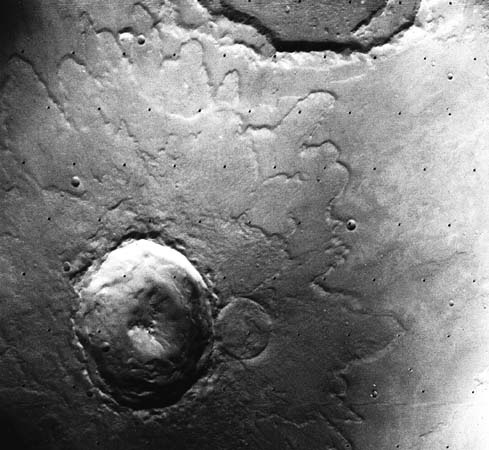 Rampart and pedestal craters may be unique to Mars. A rampart crater is so named because the lobes of ejecta—the material thrown out from the crater and extending around it—are bordered with a low ridge, or rampart. The ejecta thus apparently flowed across the ground, which may indicate that it had a mudlike consistency. Some scientists have conjectured that the mud formed from a mixture of impact debris and water that was present under the surface. Around a pedestal crater, the ejected material forms a steep-sided platform, or pedestal, with the crater situated inside its border. The pedestal appears to have developed when wind carved away the surface layer of the surrounding region while leaving intact that portion protected by the overlying ejecta.
Rampart and pedestal craters may be unique to Mars. A rampart crater is so named because the lobes of ejecta—the material thrown out from the crater and extending around it—are bordered with a low ridge, or rampart. The ejecta thus apparently flowed across the ground, which may indicate that it had a mudlike consistency. Some scientists have conjectured that the mud formed from a mixture of impact debris and water that was present under the surface. Around a pedestal crater, the ejected material forms a steep-sided platform, or pedestal, with the crater situated inside its border. The pedestal appears to have developed when wind carved away the surface layer of the surrounding region while leaving intact that portion protected by the overlying ejecta.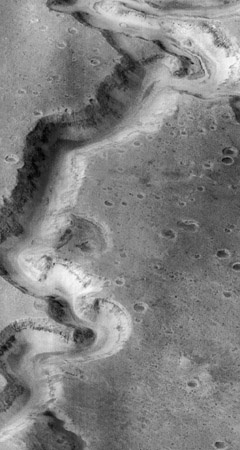
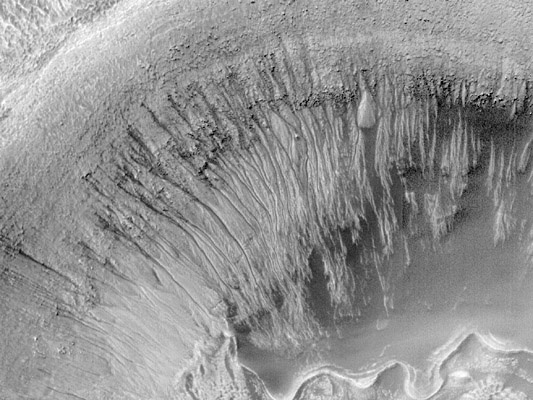 High-resolution Viking images revealed an additional characteristic of the ancient southern terrain—the pervasive presence of networks of small valleys that resemble terrestrial drainage systems created by flowing water. Examples include Nirgal Vallis, located in the southern hemisphere north of the Argyre impact basin, and Nanedi Vallis, located just north of the equator near the east end of Valles Marineris. Scientists have proposed two alternative mechanisms for their formation, either the runoff of rainfall on the surface or erosion by the outflow of groundwater that seeped onto the surface. In either case, warm climatic conditions may have been required for their formation. A major surprise of the Mars Global Surveyor mission was observation of small, fresh-appearing gullies on steep slopes at high latitudes. These features strongly resemble water-worn gullies in Earth's desert regions, but their origin remains controversial. Although the discoverers initially proposed water erosion as the cause, this was challenged by other researchers.
High-resolution Viking images revealed an additional characteristic of the ancient southern terrain—the pervasive presence of networks of small valleys that resemble terrestrial drainage systems created by flowing water. Examples include Nirgal Vallis, located in the southern hemisphere north of the Argyre impact basin, and Nanedi Vallis, located just north of the equator near the east end of Valles Marineris. Scientists have proposed two alternative mechanisms for their formation, either the runoff of rainfall on the surface or erosion by the outflow of groundwater that seeped onto the surface. In either case, warm climatic conditions may have been required for their formation. A major surprise of the Mars Global Surveyor mission was observation of small, fresh-appearing gullies on steep slopes at high latitudes. These features strongly resemble water-worn gullies in Earth's desert regions, but their origin remains controversial. Although the discoverers initially proposed water erosion as the cause, this was challenged by other researchers.Northern plains
The northern plains have remarkably little relief. They encompass all of the terrain within 30° of the pole except for the layered terrains immediately around the pole. Three broad lobes extend to lower latitudes. These include Chryse Planitia and Acidalia Planitia (centred on 30° W longitude), Amazonis Planitia (160° W), and Utopia Planitia (250° W). The only significant relief in this huge area is a large ancient impact basin, informally called the Utopia basin (40° N, 250° W).
Several different types of terrain have been recognized within the plains. In knobby terrain, numerous small hills are separated by smooth plains. The hills appear to be remnants of an ancient cratered surface now almost completely buried by younger material that forms the plains. Various plains have a polygonal fracture pattern that resembles landforms found in permafrost regions on Earth. Others have a peculiar thumbprint-like texture.
The origin of the low-lying northern plains remains controversial. Some scientists have proposed that they were formerly occupied by ocean-sized bodies of water that were fed by large floods (see the section Outflow channels (Mars), below). Others have seen little evidence of global-sized bodies of water and have noted the difficulty of explaining the disappearance of such large water volumes.
Outflow channels
 Large flood channels, termed outflow channels, are observed incised into the Martian surface in several areas. The channels are generally tens of kilometres across and hundreds of kilometres long. Most emerge full-size from rubble-filled depressions and continue downslope into the northern plains or the Hellas basin (Hellas) in the south. Many of the largest drain from the south and west into Chryse Planitia. These are true channels in that they were once completely filled with flowing water, as opposed to most river valleys, which have never been close to full but contain a much smaller river channel. The peak discharges of the floods that cut the channels are estimated to have been a hundred to a thousand times the peak discharge of the Mississippi River—truly enormous events. Some of the floods appear to have formed by catastrophic release of water from lakes. Others formed by explosive eruption of groundwater.
Large flood channels, termed outflow channels, are observed incised into the Martian surface in several areas. The channels are generally tens of kilometres across and hundreds of kilometres long. Most emerge full-size from rubble-filled depressions and continue downslope into the northern plains or the Hellas basin (Hellas) in the south. Many of the largest drain from the south and west into Chryse Planitia. These are true channels in that they were once completely filled with flowing water, as opposed to most river valleys, which have never been close to full but contain a much smaller river channel. The peak discharges of the floods that cut the channels are estimated to have been a hundred to a thousand times the peak discharge of the Mississippi River—truly enormous events. Some of the floods appear to have formed by catastrophic release of water from lakes. Others formed by explosive eruption of groundwater. Valles Marineris
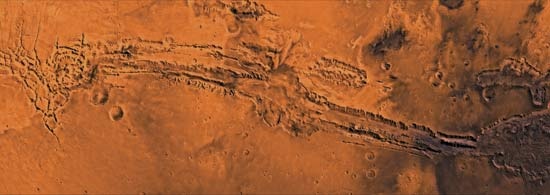
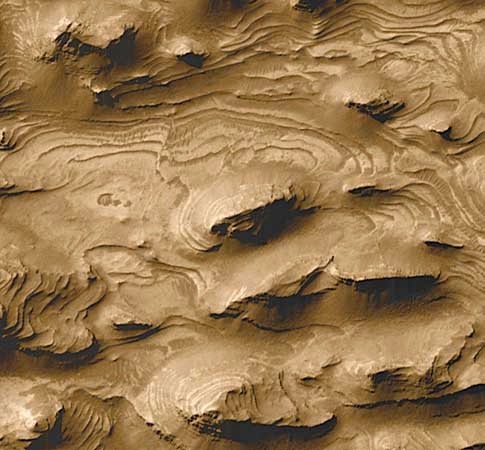 Close to the equator, centred on 70° W longitude, are several interconnected canyons collectively called Valles Marineris. Individual canyons are roughly 200 km (125 miles) across. At the centre of the system, several canyons merge to form a depression 600 km (375 miles) across and as much as 9 km (5.6 miles) deep—about five times the depth of the Grand Canyon. The entire system is more than 4,000 km (2,500 miles) in length, or about 20 percent of Mars's circumference. At several places within the canyons are thick sedimentary sequences, which suggest that lakes may have formerly occupied the canyons. Some of the lakes may have drained catastrophically to the east to form large outflow channels that start at the canyons' eastern end. How the canyons formed is not known, but faulting probably played a major role.
Close to the equator, centred on 70° W longitude, are several interconnected canyons collectively called Valles Marineris. Individual canyons are roughly 200 km (125 miles) across. At the centre of the system, several canyons merge to form a depression 600 km (375 miles) across and as much as 9 km (5.6 miles) deep—about five times the depth of the Grand Canyon. The entire system is more than 4,000 km (2,500 miles) in length, or about 20 percent of Mars's circumference. At several places within the canyons are thick sedimentary sequences, which suggest that lakes may have formerly occupied the canyons. Some of the lakes may have drained catastrophically to the east to form large outflow channels that start at the canyons' eastern end. How the canyons formed is not known, but faulting probably played a major role. Tharsis and Elysium
 The canyons of Valles Marineris terminate to the west near the crest of the Tharsis rise, a vast bulge on the Martian surface more than 8,000 km (5,000 miles) across and 8 km (5 miles) high at its centre. Near the top of the rise are three of the planet's largest volcanoes (volcano)—Ascraeus Mons, Arsia Mons, and Pavonis Mons—which tower 18, 17, and 14 km (11.2, 10.5, and 8.7 miles), respectively, above the mean radius. Just off the rise to the northwest is the planet's tallest volcano, Olympus Mons, and at the north end is yet another large volcano, Alba Patera, which approaches 7 km (4.3 miles) in height. Between these giant landforms are several smaller volcanoes and lava plains. What formed Tharsis is not known; it may have resulted from a combination of uplift and the accumulation of huge volumes of volcanic deposits.
The canyons of Valles Marineris terminate to the west near the crest of the Tharsis rise, a vast bulge on the Martian surface more than 8,000 km (5,000 miles) across and 8 km (5 miles) high at its centre. Near the top of the rise are three of the planet's largest volcanoes (volcano)—Ascraeus Mons, Arsia Mons, and Pavonis Mons—which tower 18, 17, and 14 km (11.2, 10.5, and 8.7 miles), respectively, above the mean radius. Just off the rise to the northwest is the planet's tallest volcano, Olympus Mons, and at the north end is yet another large volcano, Alba Patera, which approaches 7 km (4.3 miles) in height. Between these giant landforms are several smaller volcanoes and lava plains. What formed Tharsis is not known; it may have resulted from a combination of uplift and the accumulation of huge volumes of volcanic deposits.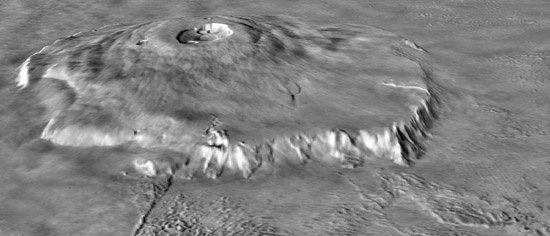 The presence of the Tharsis rise has caused stresses within, and deformation of, the crust. A vast system of fractures radiating from Tharsis and compressional ridges arrayed around the rise are evidence of this process. The radial faulting around Tharsis appears to have contributed to the formation of the Valles Marineris system.
The presence of the Tharsis rise has caused stresses within, and deformation of, the crust. A vast system of fractures radiating from Tharsis and compressional ridges arrayed around the rise are evidence of this process. The radial faulting around Tharsis appears to have contributed to the formation of the Valles Marineris system.Another volcanic rise is located in the northern region of Elysium at about 215° W longitude. Much smaller than Tharsis, being only 2,000 km (1,200 miles) across and 6 km (3.7 miles) high, the Elysium rise is also the site of several volcanoes.
The interior
The interior of Mars is poorly known. Planetary scientists have yet to conduct a successful seismic experiment via spacecraft that would provide direct information on internal structure and so must rely on indirect inferences. The moment of inertia (inertia, moment of) of Mars indicates that it has a central core with a radius of 1,300–2,000 km (800–1,200 miles). Isotopic data from meteorites determined to have come from Mars (see the section Meteorites from Mars (Mars), below) demonstrate unequivocally that the planet differentiated—separated into a metal-rich core and rocky mantle—at the end of the planetary accretion period 4.5 billion years ago. The planet has no detectable magnetic field that would indicate convection (heat-induced flow) in the core today. Large regions of magnetized rock have been detected in the oldest terrains, however, which suggests that very early Mars did have a magnetic field but that it disappeared as the planet cooled and the core solidified. Martian meteorites also suggest that the core may be more sulfur-rich than Earth's core and the mantle more iron-rich.
Mars is almost certainly volcanically active today, although at a very low level. Some Martian meteorites, which are all volcanic rocks, show ages as young as a few hundred million years, and some volcanic surfaces on the planet are so sparsely cratered that they must be only tens of millions of years old. Thus, Mars was volcanically active in the geologically recent past, which implies that its mantle is warm and undergoing melting locally.
Mars's gravitational field is very different from Earth's. On Earth, excesses and deficits of mass in the surface crust, corresponding to the presence of large mountains and ocean deeps, respectively, tend to be offset by compensating masses at depth (isostatic compensation (isostasy)). Thus, the pull of gravity on Earth is the same on high mountains as it is over the ocean. This is also true for Mars's oldest terrains, such as the Hellas basin, the southern highlands, and the northern plains. The younger terrains, such as the Tharsis and Elysium domes, however, are only partly compensated. Associated with both of these regions are gravity highs—that is, places where the measured gravity is significantly higher than elsewhere because of the large mass of the domes. (Similar areas, called mascons, have been detected and mapped on Earth's Moon.)
Because the gravity over the southern highlands is roughly the same as that over the low-lying northern plains, the southern highlands must be underlain by a thicker crust of material that is less dense than the mantle below it. Estimates of the thickness of the Martian crust range from only 3 km (2 miles) under the Isidis impact basin, which is just north of the equator and east of Syrtis Major, to more than 90 km (60 miles) at the south end of the Tharsis rise.
Meteorites (meteorite) from Mars
By 2004 scientists had identified about 30 meteorites that have come from Mars. Suspicions about their origin were first raised when meteorites that appeared to be volcanic rocks were found to have ages of about 1.3 billion years instead of the 4.5 billion years of all other meteorites. These rocks had to have come from a body that was geologically active in the comparatively recent past, and Mars was the most likely candidate. The rocks also have similar ratios of oxygen isotopes, which are distinctively different from those of Earth rocks, lunar rocks, and other meteorites. A Martian origin was finally proved when it was found that several of them contained trapped gases having a composition identical to that of the Martian atmosphere as measured by the Viking landers. The rocks are thought to have been ejected from the Martian surface by large impacts. They then went into solar orbit for several million years before falling on Earth. Claims in the mid-1990s of finding evidence for past microscopic life in one of the meteorites, called ALH84001, have been viewed skeptically by the general science community (see the section The question of life on Mars (Mars), below).
Martian moons (moon)
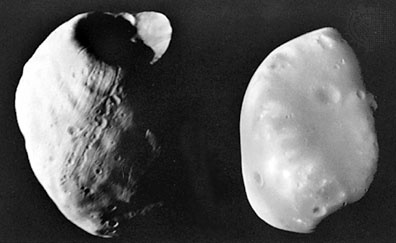 Little was learned about the two moons of Mars, Phobos and Deimos, after their discovery in 1877 until orbiting spacecraft observed them a century later. Viking 1 flew to within 100 km (60 miles) of Phobos and Viking 2 to within 30 km (20 miles) of Deimos.
Little was learned about the two moons of Mars, Phobos and Deimos, after their discovery in 1877 until orbiting spacecraft observed them a century later. Viking 1 flew to within 100 km (60 miles) of Phobos and Viking 2 to within 30 km (20 miles) of Deimos.Phobos revolves around Mars once every 7 hours 39 minutes. It moves in an exceptionally close orbit at a mean distance of about 6,000 km (3,700 miles) from the surface—less than twice the planet's radius. It is so near that, without internal strength, it would be torn apart by gravitational (tidal) forces (see Roche limit). These forces also slow the motion of Phobos and may ultimately cause the satellite to collide with Mars, possibly in less than 100 million years. Deimos suffers the opposite fate. It moves in a more distant orbit, and tidal forces are causing it to recede from the planet. Phobos and Deimos are not visible from all locations on the planet because of their small size, proximity to Mars, and near-equatorial orbits.
 Moons of MarsBoth moons are irregular chunks of rock, roughly ellipsoidal in shape. Phobos is the larger of the two (see the table (Moons of Mars)). Phobos's rugged surface is totally covered with impact craters. The largest, the crater Stickney, is about half as wide as the satellite itself. Its surface also exhibits a widespread system of linear fractures, or grooves, many of which are geometrically related to Stickney. In contrast, the surface of Deimos appears smooth, as its many craters are almost completely buried by fine debris, and it shows no fracture system. The difference in appearance between the two moons is thought to be related to the final disposition of the debris produced by impacts. In the case of the inner, more massive Phobos, the ejected material either fell back to the surface or, if it left the satellite with enough velocity to go into space, subsequently fell on Mars. For the more distant, smaller Deimos, debris thrown off the satellite remained in orbit until it was recaptured, sifting down to blanket its surface.
Moons of MarsBoth moons are irregular chunks of rock, roughly ellipsoidal in shape. Phobos is the larger of the two (see the table (Moons of Mars)). Phobos's rugged surface is totally covered with impact craters. The largest, the crater Stickney, is about half as wide as the satellite itself. Its surface also exhibits a widespread system of linear fractures, or grooves, many of which are geometrically related to Stickney. In contrast, the surface of Deimos appears smooth, as its many craters are almost completely buried by fine debris, and it shows no fracture system. The difference in appearance between the two moons is thought to be related to the final disposition of the debris produced by impacts. In the case of the inner, more massive Phobos, the ejected material either fell back to the surface or, if it left the satellite with enough velocity to go into space, subsequently fell on Mars. For the more distant, smaller Deimos, debris thrown off the satellite remained in orbit until it was recaptured, sifting down to blanket its surface.The albedo, or reflectivity, of the surfaces of both moons is very low, similar to that of the most primitive types of meteorites. One theory of the origin of the moons is that they are asteroids that were captured when Mars was forming.
Spacecraft exploration
 Since the beginning of the space age, Mars has been a focus of planetary exploration for three main reasons: (1) it is the most Earth-like of the planets; (2) other than Earth, it is the planet most likely to have developed indigenous life; and (3) it will probably be the first extraterrestrial planet to be visited by humans. Between 1960 and 1980 the exploration of Mars was a major objective of both the U.S. (United States) and Soviet (Union of Soviet Socialist Republics) space programs. U.S. spacecraft successfully flew by Mars ( Mariners 4, 6, and 7), orbited the planet (Mariner 9 and Vikings 1 and 2), and placed lander modules on its surface ( Vikings 1 and 2). Three Soviet probes (Mars 2, 3, and 5) also investigated Mars, two of them reaching its surface. Mars 3 was the first spacecraft to soft-land an instrumented capsule on the planet, on December 2, 1971; landing during a planetwide dust storm, the device returned data for about 20 seconds.
Since the beginning of the space age, Mars has been a focus of planetary exploration for three main reasons: (1) it is the most Earth-like of the planets; (2) other than Earth, it is the planet most likely to have developed indigenous life; and (3) it will probably be the first extraterrestrial planet to be visited by humans. Between 1960 and 1980 the exploration of Mars was a major objective of both the U.S. (United States) and Soviet (Union of Soviet Socialist Republics) space programs. U.S. spacecraft successfully flew by Mars ( Mariners 4, 6, and 7), orbited the planet (Mariner 9 and Vikings 1 and 2), and placed lander modules on its surface ( Vikings 1 and 2). Three Soviet probes (Mars 2, 3, and 5) also investigated Mars, two of them reaching its surface. Mars 3 was the first spacecraft to soft-land an instrumented capsule on the planet, on December 2, 1971; landing during a planetwide dust storm, the device returned data for about 20 seconds.Mariner 9, the first spacecraft to orbit another planet, was placed around Mars in November 1971 and operated until October 1972. It returned a wide variety of spectroscopic, radio-propagation, and photographic data. Some 7,330 pictures covering 80 percent of the surface demonstrated a history of widespread volcanism, ancient erosion by water, and reshaping of extensive areas of the surface by internal forces.
The central theme of the Viking missions was the search for extraterrestrial life. No unequivocal evidence of biological activity was found (see the section The question of life on Mars (Mars), below), but the various instruments on the two orbiters and two landers returned detailed information concerning Martian geology, meteorology, and the physics and chemistry of the upper atmosphere. Vikings 1 and 2 were placed into orbit during June and August 1976, respectively. Lander modules descended to the surface from the orbiters after suitable sites were found. Viking 1 landed in the region of Chryse Planitia (22° N, 48° W) on July 20, 1976, and Viking 2 landed 6,500 km (4,000 miles) away in Utopia Planitia (48° N, 226° W) on September 3, 1976.
In 1988 Soviet scientists launched a pair of spacecraft, Phobos 1 and 2, to orbit Mars and make slow flyby observations of its two satellites. Phobos 1 failed during the yearlong flight, but Phobos 2 reached Mars in early 1989 and returned several days of observations of both the planet and Phobos before malfunctioning.
 Amid failures of several U.S. spacecraft missions to Mars in the 1990s, Mars Pathfinder successfully set down in Chryse Planitia (19° N, 33° W) on July 4, 1997, and deployed a robotic wheeled rover called Sojourner on the surface. This was followed by Mars Global Surveyor, which reached Mars in September 1997 and systematically mapped various properties of the planet from orbit for several years beginning in March 1999. These included Mars's gravity and magnetic fields, surface topography, and surface mineralogy. The spacecraft also carried cameras for making both wide-angle and detailed images of the surface at resolutions down to 1.5 metres (5 feet). Mars Odyssey safely entered Mars orbit in October 2001 and started mapping other properties, including the chemical composition of the surface, the distribution of near-surface ice, and the physical properties of near-surface materials.
Amid failures of several U.S. spacecraft missions to Mars in the 1990s, Mars Pathfinder successfully set down in Chryse Planitia (19° N, 33° W) on July 4, 1997, and deployed a robotic wheeled rover called Sojourner on the surface. This was followed by Mars Global Surveyor, which reached Mars in September 1997 and systematically mapped various properties of the planet from orbit for several years beginning in March 1999. These included Mars's gravity and magnetic fields, surface topography, and surface mineralogy. The spacecraft also carried cameras for making both wide-angle and detailed images of the surface at resolutions down to 1.5 metres (5 feet). Mars Odyssey safely entered Mars orbit in October 2001 and started mapping other properties, including the chemical composition of the surface, the distribution of near-surface ice, and the physical properties of near-surface materials.A wave of spacecraft converged on Mars in late 2003 and early 2004 with mixed outcomes. Nozomi, launched by Japan in 1998 on a leisurely trajectory, was the first reach the vicinity of the planet, but malfunctions prevented it from being put into Mars orbit. In mid-2003 the European Space Agency's Mars Express was launched on a half-year journey to the Red Planet. Carrying instruments to study the atmosphere, surface, and subsurface, it entered Mars orbit on December 25; however, its lander, named Beagle 2, which was to examine the rocks and soil for signs of past or present life, failed to establish radio contact after presumably descending to the Martian surface the same day. Within weeks of its arrival, the Mars Express orbiter detected vast fields of water ice as well as carbon dioxide ice at the south pole and confirmed that the southern summer remnant cap, like the northern one, contains permanently frozen water.
 Also launched in mid-2003 was the U.S. Mars Exploration Rover Mission (Mars Exploration Rover), which comprised twin robotic landers, Spirit and Opportunity. Spirit touched down in Gusev Crater (15° S, 175° E) on January 3, 2004. Three weeks later, on January 24, Opportunity landed in Meridiani Planum (2° S, 6° W), on the opposite side of planet. The six-wheeled rovers, each equipped with cameras and a suite of instruments that included a microscopic imager and a rock-grinding tool, analyzed the rocks, soil, and dust around their landing sites, which had been chosen because they appeared to have been affected by water in Mars's past. Both rovers found evidence of past water; perhaps the most dramatic was the discovery by Opportunity of rocks that appeared to have been laid down at the shoreline of an ancient body of salty water (seawater).
Also launched in mid-2003 was the U.S. Mars Exploration Rover Mission (Mars Exploration Rover), which comprised twin robotic landers, Spirit and Opportunity. Spirit touched down in Gusev Crater (15° S, 175° E) on January 3, 2004. Three weeks later, on January 24, Opportunity landed in Meridiani Planum (2° S, 6° W), on the opposite side of planet. The six-wheeled rovers, each equipped with cameras and a suite of instruments that included a microscopic imager and a rock-grinding tool, analyzed the rocks, soil, and dust around their landing sites, which had been chosen because they appeared to have been affected by water in Mars's past. Both rovers found evidence of past water; perhaps the most dramatic was the discovery by Opportunity of rocks that appeared to have been laid down at the shoreline of an ancient body of salty water (seawater).The mapping (astronomical map) of Mars
The first known map of Mars was produced in 1830 by Wilhelm Beer (Beer, Wilhelm) and Johann Heinrich von Mädler (Mädler, Johann Heinrich von) of Germany. The Italian astronomer Giovanni Virginio Schiaparelli (Schiaparelli, Giovanni Virginio) prepared the first modern astronomical map of Mars in 1877, which contained the basis of the system of nomenclature still in use today. The names on his map are in Latin and are formulated predominantly in terms of the ancient geography of the Mediterranean area. This map also showed, for the first time, indications of an interconnecting system of straight lines on the bright areas that he described as canali (Italian: “channels”). Schiaparelli is usually credited with their first description, but his fellow countryman Pietro Angelo Secchi developed the idea of canali about a decade earlier. In the late 19th century the American astronomer Percival Lowell (Lowell, Percival) established an observatory in Flagstaff, Arizona, specifically to observe Mars, and he produced ever more elaborate maps of the Martian canals until his death in 1916.
 Observations made by Mariner 9 and subsequent Mars-orbiting spacecraft have led to many maps of topography, geology, temperature, mineral distributions, and a variety of other data. After Mariner 9, the prime meridian on Mars, the equivalent of the Greenwich meridian on Earth, was defined as passing through a small crater named Airy-0 within the larger crater Airy. Longitude was measured in degrees that increase to the west of this meridian completely around the planet. Later some scientists expressed a preference for a coordinate system having longitude that increases to the east of the prime meridian. Consequently, maps of Mars were published with either or both of these systems.
Observations made by Mariner 9 and subsequent Mars-orbiting spacecraft have led to many maps of topography, geology, temperature, mineral distributions, and a variety of other data. After Mariner 9, the prime meridian on Mars, the equivalent of the Greenwich meridian on Earth, was defined as passing through a small crater named Airy-0 within the larger crater Airy. Longitude was measured in degrees that increase to the west of this meridian completely around the planet. Later some scientists expressed a preference for a coordinate system having longitude that increases to the east of the prime meridian. Consequently, maps of Mars were published with either or both of these systems.The question of life (extraterrestrial life) on Mars
The possible presence of life on Mars has been an essential element of general discussions of the planet since Schiaparelli first included canali (Mars, canals of) on his maps. Lowell was particularly responsible for popularizing the notion that these markings were the result of biological activity, intelligent or otherwise. Nevertheless, as discussed above in the section Surface features (Mars), it has been clear since the 1960s that such features do not exist. (See the article Mars, canals of.)
 The biological (astrobiology) experiments aboard the two Viking landers addressed three issues: (1) the nature of organic material, if any, on the Martian surface, (2) the possible presence of objects on the surface whose appearance or motion would suggest living or fossilized organisms, and (3) the possible presence in Martian soil of agents that, under prescribed conditions, could indicate metabolic processes. The results related to the first issue were definite and unambiguous—a direct, extremely sensitive chemical analysis of samples at both lander sites showed no trace of complex organic materials. Addressing the second issue, the cameras on the landers found no evidence of biological agents or activity.
The biological (astrobiology) experiments aboard the two Viking landers addressed three issues: (1) the nature of organic material, if any, on the Martian surface, (2) the possible presence of objects on the surface whose appearance or motion would suggest living or fossilized organisms, and (3) the possible presence in Martian soil of agents that, under prescribed conditions, could indicate metabolic processes. The results related to the first issue were definite and unambiguous—a direct, extremely sensitive chemical analysis of samples at both lander sites showed no trace of complex organic materials. Addressing the second issue, the cameras on the landers found no evidence of biological agents or activity.Three separate instruments addressed the last issue. One, the pyrolytic release experiment, was designed to look for signs of photosynthesis or chemosynthesis—that is, signs of biological activity supported by solar or chemical energy, respectively—in samples of Martian soil. This experiment produced some positive indications, but the experimenters believed that they could be best explained by nonbiological processes. A second experiment, called the gas exchange experiment, measured gases released from a soil sample as it was exposed to a humid atmosphere or treated with a solution of organic nutrients. This experiment also produced a positive result in that the soil samples liberated substantial quantities of oxygen in response to the nutrient. This reaction, however, also occurred even after samples had been baked on-site at 145 °C (293 °F) for three hours, leading experimenters to conclude that the source of oxygen was nonbiological. Finally, the labeled release experiment looked for the release of radioactive gas when a soil sample was exposed to a solution of radioactive organic nutrient. A positive result was again obtained, and in this case a baked control sample remained inert, as would be expected if the reaction was caused by a biological agent. Nevertheless, given the results of the other Viking experiments, most investigators believe that the results of the labeled release experiment also can be explained nonbiologically.
The Martian surface is almost certainly devoid of life at the present time. It is exposed to ultraviolet radiation from the Sun without any reduction in intensity by the atmosphere. Also, organic compounds in the soil are destroyed, probably by a combination of oxidation and photochemical processes. Moreover, average temperatures are so cold and the water content of the atmosphere so low that liquid water, universally accepted as essential for life, is unlikely to be readily available, although it may be episodically and locally available in view of evidence for seemingly recent water-worn gullies (see the section Southern cratered highlands (Mars), above). These considerations have encouraged scientists to shift their search for life on Mars to the search for past life. As was indicated above, different lines of evidence suggest that conditions on early Mars were much more hospitable to life than subsequently. If life did gain a foothold, it now may survive only in protected niches well below the hostile surface. The current strategy, therefore, is to focus on evidence of past life and then look for present life below the surface or where liquid water might be episodically available.
 This strategy was underscored by the findings from the Martian meteorite ALH84001, which was collected from an Antarctic ice field in 1984. It is the oldest known rock from Mars, having formed about 4.5 billion years ago when the planet itself was accreting. It contains organic materials, evidence of mineral deposition from liquid water, and a number of structures similar to primitive terrestrial fossils. Although most scientists conclude that these findings do not provide good evidence for past life, they have stimulated closer examination of the Martian meteorites and have emphasized the need for obtaining samples from Mars, particularly of ancient rocks that were being formed or were already present when conditions on Mars were more Earth-like. (See the article extraterrestrial life.)
This strategy was underscored by the findings from the Martian meteorite ALH84001, which was collected from an Antarctic ice field in 1984. It is the oldest known rock from Mars, having formed about 4.5 billion years ago when the planet itself was accreting. It contains organic materials, evidence of mineral deposition from liquid water, and a number of structures similar to primitive terrestrial fossils. Although most scientists conclude that these findings do not provide good evidence for past life, they have stimulated closer examination of the Martian meteorites and have emphasized the need for obtaining samples from Mars, particularly of ancient rocks that were being formed or were already present when conditions on Mars were more Earth-like. (See the article extraterrestrial life.)Additional Reading
Donald Goldsmith, The Hunt for Life on Mars (1997), describes the events that led to the controversial claims for evidence of life in the Martian meteorite ALH84001. John Noble Wilford, Mars Beckons: The Mysteries, the Challenges, the Expectations of Our Next Great Adventure in Space (1990), provides a general introduction. All aspects of Mars science are addressed in Hugh H. Kieffer et al. (eds.), Mars (1992), a huge, comprehensive technical summary of existing knowledge. Victor R. Baker, The Channels of Mars (1982), is a well-illustrated discussion of how these features came about and their implications for the history of Mars. Michael H. Carr, The Surface of Mars (1981), is a profusely illustrated survey of scientists' perception of Mars after the Viking missions, and Water on Mars (1996) discusses the role that water has played in the evolution of the Martian surface. Volumes of papers detailing the results of the various Mars spacecraft missions appear in the Journal of Geophysical Research: for Viking, 82, no. 28 (1977); for Mars Pathfinder, 104, no. E4 (1999); and for Mars Global Surveyor, 106, no. E4 (2001). These results are summarized in several excellent papers in Nature 412:207–253 (July 12, 2001).
- John Harrison
- John Harvard
- John Harvey Kellogg
- John Havlicek
- John Hawkes
- John Hawkesworth
- John Hay
- John Hays Hammond
- John Hays Hammond, Jr.
- John Hays, Jr. Hammond
- John Hay Whitney
- John Heathcoat
- John Heisman
- John Held, Jr.
- John Heminge
- John Henninger Reagan
- John Henry
- John Henry Anderson
- John Henry Belter
- John Henry Comstock
- John Henry Dallmeyer
- John Henry Hobart
- John Henry Holland
- John Henry Lloyd
- John Henry Newman